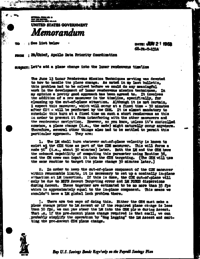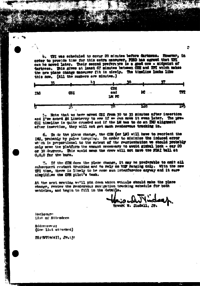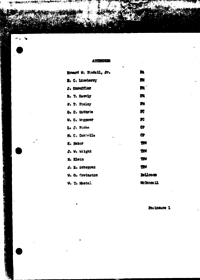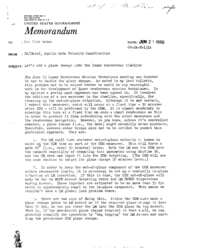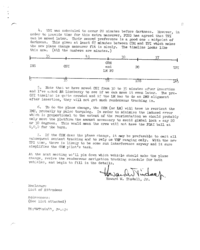See list belowJUN 21 196868-PA-T-131APA/Chief, Apollo Data Priority CoordinationLet’s add a plane change into the lunar rendezvous timeline
The June 13 Lunar Rendezvous Mission Techniques meeting was devoted to how to handle the plane change. As noted in my last bulletin, this problem had to be solved before we could do any meaningful work in the development of lunar rendezvous mission techniques. In my opinion a pretty good approach has been agreed to. It involves the addition of a new maneuver in the timeline, specifically, for cleaning up the out-of-plane situation. Although it is not certain, I expect this maneuver, which will occur at a fixed time – 30 minutes after CDH – will be performed by the CSM. It is almost mandatory to schedule this burn at a fixed time on such a short rendezvous as this in order to prevent it from interfering with the other maneuvers and the rendezvous navigation. However, as you known unless it's controlled somehow, a plane change (i.e., the node) might naturally occur anywhere. Therefore, several other things also had to be settled to permit this particular approach. They are:
1. The LM shall burn whatever out-of-plane velocity is known to exist at the CDH time as part of the CDH maneuver. This will force a node 90° (i.e., about 30 minutes) later. Both the LM and the CSM have the onboard capability of computing this parameter using Routine 36, and the CM crew can input it into the CDH targeting. (The CSM will use the same routine to target its plane change 30 minutes later.)
2. In order to keep the out-of-plane component of the CDH maneuver within reasonable limits, it is necessary to set up a nominally in-plane situation at LM insertion. If this is done, the CDH out-of-plane will only be due to MSFN Ascent Targeting error and LM PGNCS dispersions during Ascent. These together are estimated to be no more than 35 fps which is approximately equal to the in-plane component. This means we shouldn't have a LM gimbal lock problem there.
3. There are two ways of doing this. Either the CSM must make a plane change prior to LM Ascent or if the required plane change is less than 50 fps, we can yaw steer the LM into the CSM plane during Ascent. That is, if the pre-Ascent plane change required is that small, we can probably simplify the operation by “dog legging” the LM Ascent and omit- ting the pre-Ascent CSM plane change.
4. TPI was scheduled to occur 20 minutes before darkness. However, in order to provide time for this extra maneuver, FCSD has agreed that TPI can be moved later. Their second preference is a good one – midpoint of darkness. This gives at least 67 minutes between CDH and TPI which makes the new plane change maneuver fit in nicely. The timeline Looks like this now. (All the numbers are minutes.)
| 35 | 43 | 30 | 37 | CDH INS CSI and PC TPI LM PC
| | | | | 0 35 78 108 145
5. Note that we have moved CSI from 30 to 35 minutes after insertion and I've asked Ed Lineberry to see if we can move it even later. The pre- CSI timeline is quite crowded and if the LM has to do an IMU alignment after insertion, they will not get much rendezvous tracking in.
6. To do the plane change, the CSM (or LM) will have to reorient the IMU, probably by pulse torquing. In order to minimize the induced error which is proportional to the extent of the reorientation we should probably only move the platform the amount necessary to avoid gimbal lock – say 20 or 30 degrees. This would mean the crew will not have the FDAI ball at 0,0,0 for the burn.
7. If the CSM does the plane change, it may be preferable to omit all subsequent sextant tracking and to rely on VHF ranging only. With the new TPI time, there is likely to be some sun interference anyway and it sure simplifies the CSM pilot's task.
At the next meeting we'll pin down which vehicle should make the plane change, review the rendezvous navigation tracking schedule for both vehicles, and begin to fill in the details.
- Jul 02, 1968 – Lunar rendezvous shaping up (9.0σ)
- Sep 23, 1968 – G Rendezvous Mission Techniques (7.1σ)
- Jul 30, 1968 – Pulse Torquing to Achieve IMU Realignments (4.5σ)

